I love drinking tea from glass vessels and, reader, I must confess I have a problem. I have a penchant for buying glass tea infuser cups when they’re on sale. To assuage my guilt, I thought I’d better write about a few I’ve had so you can get a sense of why I like them and maybe as a buying guide if you want one (or two, or three) for yourself.
Tipcup
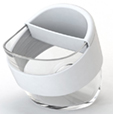 The concept behind Tipcup is hard to grasp at first but the best way to describe this strange looking vessel is that it’s like having a glass cup with two bottom surfaces: resting on one, the tea is steeping; tipping it to rest on the other, it stops steeping. The fancy design is all because of the (removable) infuser lip that sits below the waterline of a full cup when steeping, then sits above the water after you tip the cup.
The concept behind Tipcup is hard to grasp at first but the best way to describe this strange looking vessel is that it’s like having a glass cup with two bottom surfaces: resting on one, the tea is steeping; tipping it to rest on the other, it stops steeping. The fancy design is all because of the (removable) infuser lip that sits below the waterline of a full cup when steeping, then sits above the water after you tip the cup.
It’s an ingenious way of encouraging lazy people to drink loose-leaf tea. The infuser is wide enough to accommodate enough tealeaves for the 260ml cup and you don’t have to do all that very careful lifting and draining to remove the infuser without having it drip everywhere. I should also add the infuser is quite fine, which means it deals well with skinny leaves, even larger kinds of tea dust, and the whole thing is quite easy to wash.
Although the Tipcup is made of single-walled glass, it’s quite thick so retains heat about as well as thin ceramic. There’s also a silicone band for grip and heatproofing in case you think the contents are hot enough to scald your hands.
At US$28.90, it’s not really in everyone’s teacup budget and to be honest I don’t use mine all that often because of its small size and its incompatibility with balled oolongs (the infuser basket doesn’t allow the leaves to open fully).
And, despite loving the concept, I find the angled bottom surface a bit difficult to deal with mentally. When I notice the cup out of the corner of my eye I get nervous as it looks like it’s, well, tipping. I also have to be quite careful putting the cup down onto a table because my initial instinct is to have the bottom surface square and if that happens, the cup will naturally lean to one of the two bottom surfaces and slosh the contents around.
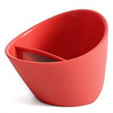 I should also add that the glass Tipcup has a thermoplastic friend, the Magisso (US$24.90), which I also bought because if you’re going to ship something from the US to Australia you may as well make it worthwhile. The Magisso doesn’t have a removable infuser like the glass Tipcup, instead it has a removable infuser screen, which makes the vessel super easy to clean. It also seems to be slightly larger than the glass version and, because it’s made of plastic, a rather good cup to travel with if you’re going to BYO tealeaves.
I should also add that the glass Tipcup has a thermoplastic friend, the Magisso (US$24.90), which I also bought because if you’re going to ship something from the US to Australia you may as well make it worthwhile. The Magisso doesn’t have a removable infuser like the glass Tipcup, instead it has a removable infuser screen, which makes the vessel super easy to clean. It also seems to be slightly larger than the glass version and, because it’s made of plastic, a rather good cup to travel with if you’re going to BYO tealeaves.
Watch how it works on the Tipcup site.
Arcosteel Double Wall Glass Cup
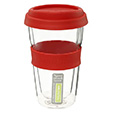 So I realise this cup doesn’t actually have an infuser but I bought it because I often make myself a pot of tea in the morning and then realise halfway through breakfast that I’m running late, so I was after a cup I could pour my tea into that would keep warm on my commute.
So I realise this cup doesn’t actually have an infuser but I bought it because I often make myself a pot of tea in the morning and then realise halfway through breakfast that I’m running late, so I was after a cup I could pour my tea into that would keep warm on my commute.
The double wall glass does indeed keep the tea warm and the silicone rubber lid is easy to put on and sip through. It also has a band for grip so it doesn’t slip from your grasp in the wet.
Unfortunately Arco died suddenly in a kitchen sink accident when a teaspoon I was washing fell into the cup, the focused force causing the inner wall of the glass to crack. At least the glass is recyclable. And I kept the lid and grip.
I got this for like $5 at Woolworths, though I understand the normal price is $10. You could probably find out where to get it at arcosteel.com.au
Samadoyo Glass Tea Cup with Infuser
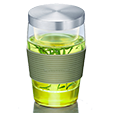 The Samadoyo isn’t double-walled but it does have two layers of glass: the inner part is an infuser with thin slits at the bottom and the outer vessel is a generous 500ml cup. There’s also a silicone grip on the infuser rim and outer cup (also good for insulation so you don’t scald your hands) and a stainless steel lid—upturned, you can rest the infuser on it once the brewing time is done.
The Samadoyo isn’t double-walled but it does have two layers of glass: the inner part is an infuser with thin slits at the bottom and the outer vessel is a generous 500ml cup. There’s also a silicone grip on the infuser rim and outer cup (also good for insulation so you don’t scald your hands) and a stainless steel lid—upturned, you can rest the infuser on it once the brewing time is done.
I love this cup. Its 500ml capacity makes it perfect for the minimum amount of water in most kettles. I use it when I want a lazy brew and it’s awesome for green tea as the glass loses heat really quickly.
The infuser is generous in size and lets the tealeaves move around and expand, but I have to say it’s a bitch to clean really fine tea like sencha because it gets caught in the slits and my hand doesn’t fit into the infuser so there’s a lot of toothbrush work (and swearing, don’t forget the swearing).
In any case, Sam’s infuser also perished in a kitchen sink accident. Apparently it did not like being dropped from a height. I maintain my innocence.
I bought mine off eBay for $26.99 (including postage from China) and you can generally find them for about $30 from retailers like Topotea (Sussex Centre, Sydney).
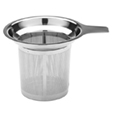 I continued to use Sam with the aid of a Metaltex infuser, which I bought for $9 at McIver’s in Melbourne. The best part is this infuser is large and versatile enough to be used across different mugs and also fine enough to take small-leaf tea. Made of stainless steel, it is also unlikely to go the way of Sam’s original infuser and, had Arco survived, I may well have used this instead of brewing and pouring from a teapot.
I continued to use Sam with the aid of a Metaltex infuser, which I bought for $9 at McIver’s in Melbourne. The best part is this infuser is large and versatile enough to be used across different mugs and also fine enough to take small-leaf tea. Made of stainless steel, it is also unlikely to go the way of Sam’s original infuser and, had Arco survived, I may well have used this instead of brewing and pouring from a teapot.
Beleaf Double Wall Glass Cup with Infuser
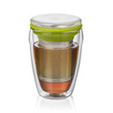 This little fella I picked up at Coles on a whim, though quite some time after Arco died. The stainless steel infuser of fine mesh is quite generously proportioned, so it works with all sizes of tealeaves and you can rest the infuser on the upturned lid when you’re done brewing. The double-walled glass + lid keeps the heat in.
This little fella I picked up at Coles on a whim, though quite some time after Arco died. The stainless steel infuser of fine mesh is quite generously proportioned, so it works with all sizes of tealeaves and you can rest the infuser on the upturned lid when you’re done brewing. The double-walled glass + lid keeps the heat in.
The highlight is really the infuser rather than the cup. You can use it with other cups and the silicone grip on the rim ensures it’s not too hot to handle when it’s time to pull out.
The biggest drawback is probably its size. I reckon it holds 300ml, which is fine for a quick tea break but smaller than my preferred session.
As far as I can tell you can only get this at Coles, and not every Coles at that. Expect to pay $10-15 depending on whether it’s on special.
General tips
Here are a few things I learnt about glass and tea throughout my drinking:
- Glass is a neutral, inert material (which is why scientists use glass test tubes and beakers etc for many experiments). This also means it does not absorb flavours from tea very easily so it all goes onto your tongue and you get the full flavour of the tea when you drink from a glass vessel.
- Glass is a good conductor of heat. That means it loses heat very quickly, which is bad if you’re a sipper and need to keep your brew hot for a good while, but excellent if you want to drink your tea soon after brewing. I also find glass excellent for brewing teas that need a lower temperature like Japanese green teas.
- Opt for borosilicate glass, not soda glass. Borosilicate glass is the stuff that withstands hot water; soda glass, which is usually used for tumblers, will crack if you try to brew hot tea in it. The product info will generally indicate whether it is/is not suitable for hot water.
- Double-walled glass vessels are a good option if you like the neutrality of glass but not its heat-losing properties. The walls trap heat in the air between, creating a pocket of insulation.
- Glass vessels are also happy on tea-warming apparatus such as candle warmers and electric heating pads. Just make sure other non-glass parts of the cup (eg grip bands) are heatproof.
- It breaks, sometimes with little force. Don’t drop it or drop things into it.
Happy tea drinking!